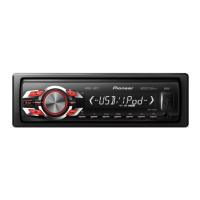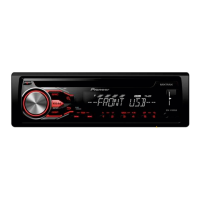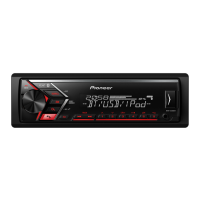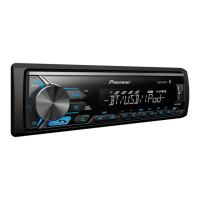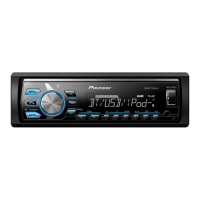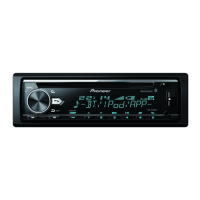
Do you have a question about the Pioneer MVH-150UBG and is the answer not in the manual?
| DIN Size | Single DIN |
|---|---|
| Channels | 4 |
| Display Type | LCD |
| USB Port | Yes |
| USB Input | Yes |
| AUX Input | Yes |
| MP3 Playback | Yes |
| WMA Playback | Yes |
| Supported Formats | MP3, WMA |
| Radio Tuner | Yes |
| Bluetooth | No |
| Detachable Face | Yes |
| Remote Control | No |
| Max Power Output | 50 W |
| RMS Power Output | 22 W |
| Tuner Bands | FM, AM |
| Equalizer | 5-band |
This section provides initial information about the product and guidance on how to effectively use the manual for reference.
Provides an overview of the unit's tuner frequency allocation and the regional limitations of the RDS function.
Offers guidance on the proper disposal of electronic products to comply with environmental regulations.
Advises users on initial steps to take when the unit fails to operate properly.
Identifies and labels the main physical components of the head unit for user reference.
Details the meaning of various indicators shown on the unit's display and their corresponding states.
Guides users through the initial setup menu options available upon first use of the unit.
Provides instructions for safely removing and reattaching the detachable front panel for security.
Explains the fundamental procedures for turning the unit on and off.
Covers selecting audio sources (TUNER, USB, AUX) and adjusting the unit's volume level.
Details methods for navigating through menus and returning to previous displays or the main menu.
Explains how to select radio bands, tune stations, and store/recall favorite stations.
Explains how to cycle through and display different types of information on the unit's screen.
Allows tuning into radio stations based on their program type (PTY) information.
Lists the available program types for use with the PTY tuning function.
Provides access to various settings for customizing unit functions.
Details specific settings for the tuner, including BSM, REGION, LOCAL, TA, AF, NEWS, and SEEK key assignment.
Covers connecting, playing, stopping, navigating, and switching USB storage devices.
Explains how to cycle through and display information related to USB playback.
Describes the process of selecting and playing files from a USB device using its name list.
Covers the use of special buttons for playback control on USB devices.
Explains how to set repeat modes (ALL, ONE, FLD) and enable random playback.
Details how to pause and resume audio playback from a USB device.
Describes features that enhance the quality of compressed audio.
Explains the Sound Retriever (S.Rtrv) function for restoring rich sound from compressed audio.
Covers speaker balance, equalizer, loudness, subwoofer, bass, and filter settings.
Covers adjusting the balance between front/rear and left/right speakers.
Explains equalizer presets, custom settings, and the loudness compensation feature.
Details subwoofer output control, bass boost, and high-pass filter adjustments.
Allows adjusting the volume level of each source to prevent abrupt changes.
Covers various settings accessible through the system menu.
Covers setting the display language, clock time, and time notation format.
Includes settings for Auto PI seek, auxiliary input activation, and power saving mode.
Provides instructions for adjusting the brightness of the unit's display illumination.
Guides users on setting up initial menu options like FM tuning and output modes.
Covers setting the FM tuning step and configuring rear/preout speaker modes.
Details how to connect and use an external audio source via the AUX input.
Provides steps to turn off unwanted displays like DEMO OFF mode.
Outlines general wiring and connection guidelines for installation.
Explains critical wiring for ACC and non-ACC ignition switch positions to prevent battery drain.
Lists essential safety precautions to follow during unit installation.
Identifies the various input and output ports on the unit itself.
Illustrates the correct connections for the power cord and ISO connector.
Explains how to connect an optional power amplifier for enhanced audio output.
Describes the front-mount and rear-mount installation methods for the unit.
Provides a step-by-step guide for installing the unit using the DIN front-mount method.
Provides a step-by-step guide for installing the unit using the DIN rear-mount method.
Details the steps required to remove the unit installed via the DIN rear-mount method.
Reiterates and clarifies the process for removing and reattaching the front panel for security.
Provides instructions on how to safely extract the unit from the dashboard assembly.
Covers common operational symptoms, causes, actions, and general error message interpretations.
Details specific error messages and causes related to USB storage device connectivity and playback.
Provides detailed explanations for specific error codes encountered during operation.
Offers guidelines for handling USB storage devices and basic usage recommendations.
Outlines the specifications and compatibility for compressed audio file formats (WMA, MP3, WAV).
Specifies bit rates, sampling frequencies, and compatibility for WMA, MP3, and WAV files.
Details limitations related to USB device partitioning, folder hierarchy, and playback.
Explains USB partitioning limits and methods for specifying audio file playback sequence.
Provides a chart for Russian characters to aid in text display interpretation.
Lists copyright notices and trademarks associated with the product and its software.
Details the general power, grounding, dimensions, and weight specifications of the unit.
Provides detailed specifications for the unit's audio output, equalizer, and subwoofer features.
Lists the specifications related to the unit's USB interface and supported file systems.
Outlines the frequency ranges, usable sensitivity, and signal-to-noise ratios for FM, MW, and LW tuners.



